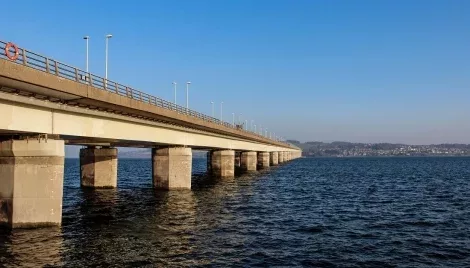Work to upgrade the Tay Road Bridge in Dundee will start next month.
From early June, and again in spring and summer 2024, crossing will be via a contraflow arrangement, with one carriageway closed and both Fife and Dundee-bound traffic using the remaining carriageway on a single lane basis.
The works see the original 1966 surface completely removed down to the concrete bridge deck and waterproofing applied before a new asphalt surface is laid on top. In addition, 92 new expansion or movement joints will also be installed.
Chair of the Tay Road Bridge Joint Board Cllr Gary Holt of Fife Council said: “We need to do these works to keep the bridge in good condition and safe to use for all users.
“The road surface has never been completely replaced since the bridge was built and the joints were last changed between 30 and 36 years ago, so they are nearing the end of their natural life.
“A new road surface will provide a safer and smoother journey across the bridge for users.”
While the bridge will be accessible for most vehicle types, wide and abnormal loads will not be able to cross with traffic going in opposite directions separated by reflective marker posts and restricted to a single lane.
The shared path will remain open in both directions at most times but may be subject to some restrictions during certain work activities. Users can keep up to date with the works on the bridge’s twitter account @tay_road_bridge.
Cllr Holt added: “Bridge users must expect delays to their journey during these essential works, and a short diversion will be posted for local traffic accessing the bridge northbound from the B946.
“As part of the extensive planning and preparation that was done for the works the Board commissioned an appraisal of alternative transport options which took a detailed and thorough look at measures which could reduce the impact on bridge users because of the works.
“The consultants looked at a total of 21 options, which mostly fell into three categories – bus, rail and park and ride/stride, although reinstatement of tolls and ferries were also included.
“When the options were evaluated, as well as the aim of reducing peak time traffic, the consultants also considered practicality, value for money and opportunities for making longer-term improvements.
“It may seem obvious but the best way of reducing congestion and with it delays, is to reduce the number of private cars, particularly those with single occupancy, crossing the bridge at peak times, but this does require people who use the bridge to change their habits.”
During the works a maximum speed limit of 30mph will be in place along the length of the bridge to protect bridge users and contractors working on the site.
The speed limit will also reduce delays as lower speeds have been shown to result in less damage to the marker posts, meaning less temporary lane closures to make good the damage.
Enabling works will start on Monday (May 1) in advance of the major closures.
Tayside Contracts will be removing kerbing at the access/egress points to the carriageways at both end of the bridge to improve carriageway width, which may result in some delays over the next few days.

























